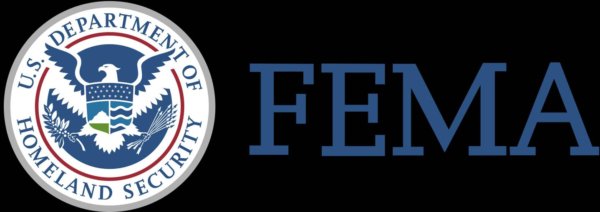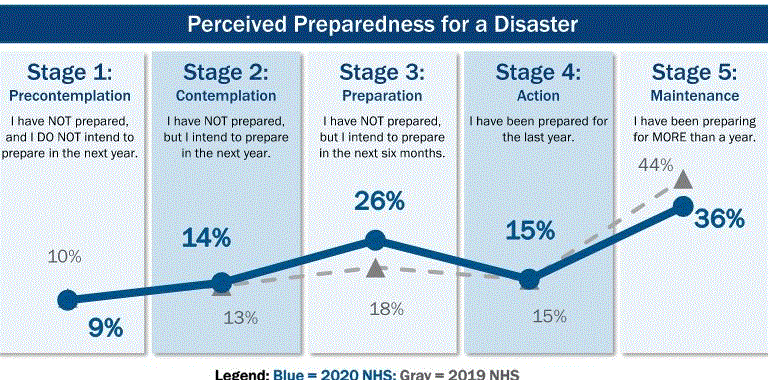
Every year FEMA comes out with its National Household Survey on Preparedness. The 2020 survey – with estimated results — just appeared. (It seems odd to me that 2020 results would be released with 3 months still to go in the year, but . . .?)
While the survey results do show progress, they are not exactly ideal: only 51% of the US population considers itself prepared, up just 2 points since 2019. (You could say that this household survey confirms, again, why Joe and I continue our work at Emergency Plan Guide!!)
Let’s see how well you are doing.
Just for fun, here are a couple of little quizzes to see how you measure up! Of course, since you are reading this Advisory I’ll bet that your answers will put you into the very top tier of “preppers.”
If you are working with a group, please consider turning this Advisory into a newsletter article or an email exercise, and then compare your group results with what the 5,000 FEMA interviewees said!
Comparing national Basic Preparedness Actions.
FEMA defines six basic preparedness actions, and in 2020 about 68% of the people interviewed took at least 3 of them.
So here are the six basic actions. Which ones did YOU take in 2019?
| Action | Yes, I did | No, I did not |
| Attend a local meeting or training | ||
| Talk with others on getting prepared | ||
| Make an emergency plan | ||
| Seek information on preparedness | ||
| Participate in an emergency drill | ||
| Gather supplies to last 3 or more days |
And here’s what the survey says about your neighbors!
| Action | National percentage who did |
| Attend a local meeting or training | 29% |
| Talk with others on getting prepared | 48% |
| Make an emergency plan | 48% |
| Seek information on preparedness | 65% |
| Participate in an emergency drill | 56% |
| Gather supplies to last 3 or more days | 81% |
Comparing national household financial preparedness.
How well are people prepared for a financial emergency? The coronavirus pandemic has certainly shed some light on our savings habits . . ! But even in 2019, when we’d never heard the word “Novel,” the National Household Survey found that while 68% of adults have set aside some money for an emergency, only about half of them had more than $700. That number didn’t change in the 2020 survey.
Note: When I wrote the mini book on Emergency Cash it included a fictional story about the costs associated with a 200 mile, one-way evacuation from a hurricane-threatened coast to a relative’s house inland. Costs in the story quickly added up to close to $600, just to get there!
Clearly, emergencies take extra cash. How much do you have set aside? _____ Or, given today’s income challenges, how much is your goal for emergency savings? ______
What influences preparedness?
The study gathers information on four things that influence people’s decision to begin preparing. One of the four stands out as having the greatest influence. The other 3 seem to have a similar degree of influence.
Here are the four influencers. Which one do you think has twice the influence of the others?
- Awareness of information – That is, I have read, seen or heard information in the past six months about how to get better prepared for a disaster.
- Experience with disasters – I have personal or familial experience with the impact of a disaster.
- Preparedness efficacy – I believe that preparing can help AND I am confident in my ability to prepare.
- Risk perception – I recognize that at least one disaster type could impact where I live.
To answer the previous question, Item #4 has a 98% correlation with influencing people to start preparing. The other three only have a 47% correlation.
Measuring preparedness behavior change.
As we look at this last excerpt from the National Household Preparedness study, it offers some perspective for preparedness leaders.
FEMA uses a Stages of Change Model to measure attitude and behavior regarding preparedness. This chart measures changes between 2013 (grey line) to estimated 2020 (blue line). You can see how slow progress has been over these seven years! The only good news from 2020 is that more people “intend to prepare in the next six months.” (Stage 3)

What recommendations come out of this study for local groups and their leaders?
As I read these statistics, and fit them in with my own experience, I find at least 3 things that stand out to guide all our efforts.
- We need to make neighbors understand what threats we face in our individual communities. And not just a name of a threat, like “hurricane” or “earthquake,” but details about alerts and warnings of danger, what damage could be caused, what to expect from authorities, and exactly how to best prepare for that threat. (This includes dispelling out-of-date recommendations like parking under an overpass during a tornado, or standing in a doorway during an earthquake!)
- We need to emphasize that preparing for this threat is doable and will make a difference in how we get through or even how we survive. Simple step-by-step instructions will give people confidence they can do this. When you focus on the role of everyday household items for preparedness, like a flashlight or extra phone-charger, you are showing that preparing doesn’t need to be expensive.
- Sponsoring local neighborhood meetings is the best way to share information about threats and preparing! (Haven’t we been saying and doing this all along?!)
When FEMA started their surveys way back in 2007, they studied a few factors that were not mentioned in the 2020 survey. I pulled out some info from earlier studies and am including it below. It certainly fits with my own experiences.
- Information needs to be customized to the community – considering language, experiences with disasters, experience with law enforcement, etc.
- Social networks within the community have a powerful influence on preparedness behavior. In particular, volunteering in preparedness/safety/disaster-related organizations spreads and strengthens knowledge and commitment.
Next steps for our groups.
Here in our neighborhood we are not yet back to regular, face-to-face meetings, so our ability to share detailed information is limited. Yes, we do publish various email announcements. And other groups are arranging for conference calls and zoom meetings to keep their members motivated.
However you manage your meetings, I hope you’ll consider what FEMA has discovered via its National Household Survey and use that information to encourage your attendees to learn more and do more. As I’ve sure you’ve found, once people start taking preparedness actions, it’s much easier for them to keep taking more. We can all strive to beat that 51% preparedness level in our neighborhoods!
Good luck with your own meetings, whether it’s just your family or includes neighbors or other social groups.
Virginia
Your Emergency Plan Guide team
P.S. Looking for inspiration? Our book of Emergency Preparedness Meeting Ideas has plenty of meeting suggestions that can be readily converted from face-to-face to online format.
P.P.S. If you’d like to see the full FEMA National Household Survey report, you can get summary results here. On that same page you’ll find links to 2 videos that present the entire study.
Don't miss a single Advisory.
Thank you for subscribing.
Something went wrong.
